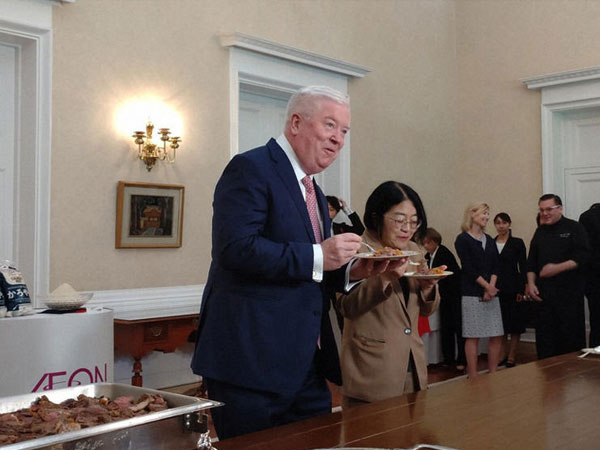 TOKYO -- U.S. Ambassador to Japan George Glass, who assumed his position in April, contributed an opinion piece to the Mainichi Shimbun regarding exports of U.S. rice, stating, "American and Japanese rice farmers can join forces to bring relief to Japanese households." Below is the full text.
TOKYO -- U.S. Ambassador to Japan George Glass, who assumed his position in April, contributed an opinion piece to the Mainichi Shimbun regarding exports of U.S. rice, stating, "American and Japanese rice farmers can join forces to bring relief to Japanese households." Below is the full text.
Rice: Easing the Burden on Japanese Consumers
By U.S. Ambassador to Japan George Glass
My first few weeks in Japan as the U.S. Ambassador have reinforced for me the indispensable role of rice in the national diet. Whether it's part of a lunch bento, a sushi dinner, or an onigiri on the go, rice is eaten at least once a day by most Japanese.
So, when the price of that staple increases drastically, every consumer and family is impacted. With a standard 5-kilogram bag of rice now twice as much as it was a year ago, Japanese consumers are having to make hard choices about what they buy and what they eat each day. Since food represents the largest share of monthly spending for Japanese households, the current rice situation is, naturally, causing concern across the country.
Americans understand what it feels like when the price of a staple food skyrockets. Last year, the United States faced its own crisis when a bird flu outbreak led to a dramatic surge in egg prices. To help mitigate a shortage, the U.S. government looked for a solution overseas, temporarily sourcing eggs from producers as far away as South Korea and Turkey. Within a remarkably short period, egg supplies stabilized and prices returned to near-normal levels. It was bold and unconventional thinking that averted an even worse situation for American consumers.
While many Japanese may not immediately associate rice with America, it has been grown in California for more than a century. Initially using methods learned from Japanese growers, farmers in California now produce high-grade rice varieties that meet the exacting standards of the Japanese market. Getting their Calrose rice on supermarket shelves in Japan, however, can be a bigger challenge.
The California farmers receive around $670 (approx. 97,000 yen) per ton for their rice, which is a fair market price. But, by the time the same rice reaches the kitchen of a Japanese family, its price has ballooned to around $5,500 (roughly 800,000 yen) per ton. Multiple charges and costs applied once the rice arrives in Japan add an extra 3,500 yen to a 5-kilogram bag. It's an arrangement with no tangible benefit for the Japanese consumer.
Japan's rice challenge has highlighted the urgent need for a trading system that is flexible and responsive to market needs. Reform doesn't mean undermining the livelihoods of Japanese farmers, either. As somebody with roots in farming in my home state of Oregon, I understand the essential role our agricultural sector plays in our economies and communities. I also know what it's like to wake up before dawn and spend all day, whatever the weather, tending to livestock or crops. It's hard work that requires determination and adaptability.
Like Japanese farmers, American farmers are proud and dedicated stewards of the land they cultivate and the animals they raise. And just as they deserve to be paid fairly for what they produce, consumers deserve to pay a fair price for it.
As last year's egg challenges in the U.S. showed, when a nation's food security is at stake, it takes resourcefulness, ingenuity, and even help from your friends to ensure supply chains are secure and supermarket shelves are stocked.
The United States and Japan have a long history of helping each other in times of adversity, just as our two countries have worked together for decades to preserve peace and deliver development to nations across the world. Now, in another example of what we can accomplish as friends and partners, American and Japanese rice farmers can join forces to bring relief to Japanese households.














© Copyright 2025 The SSResource Media.
All rights reserved.